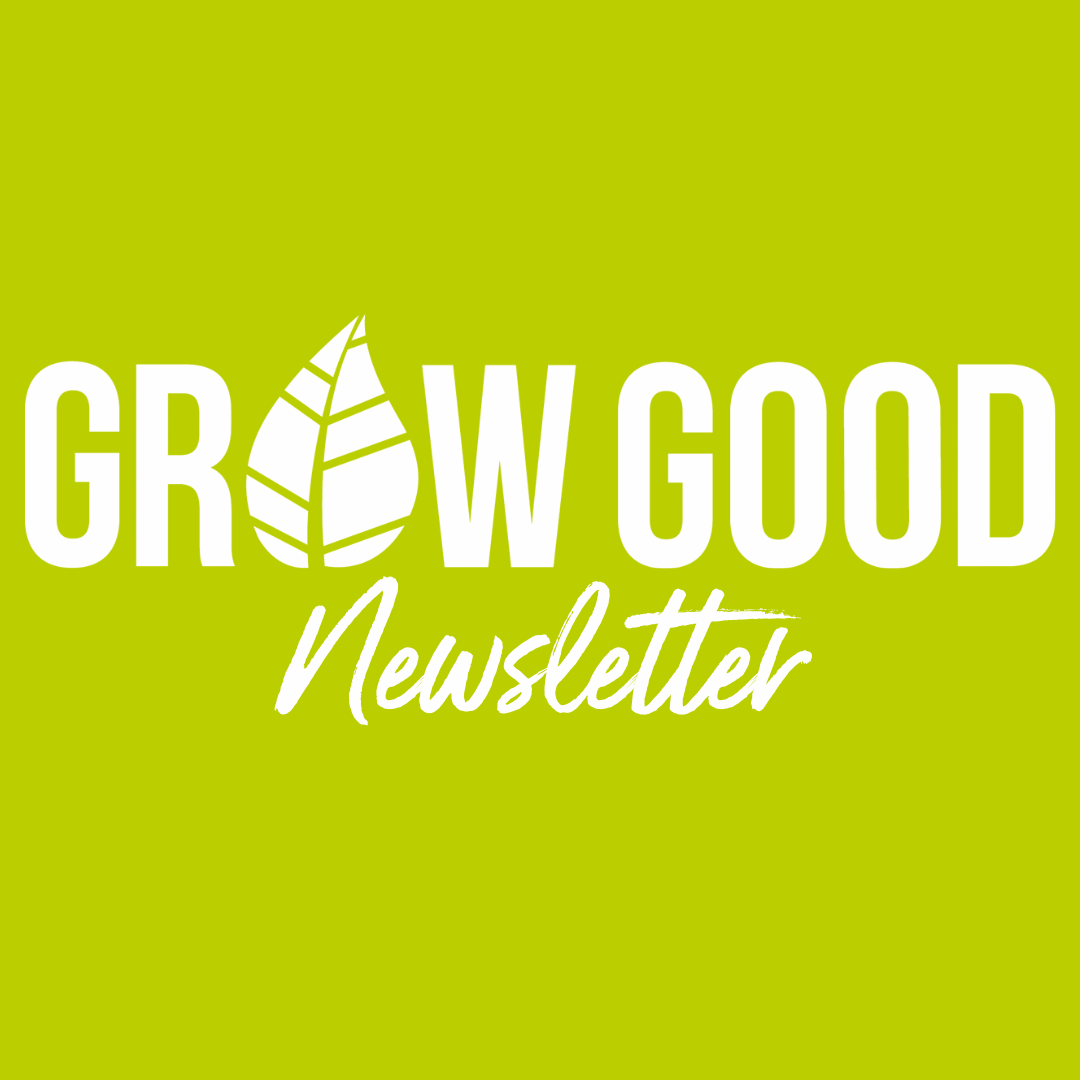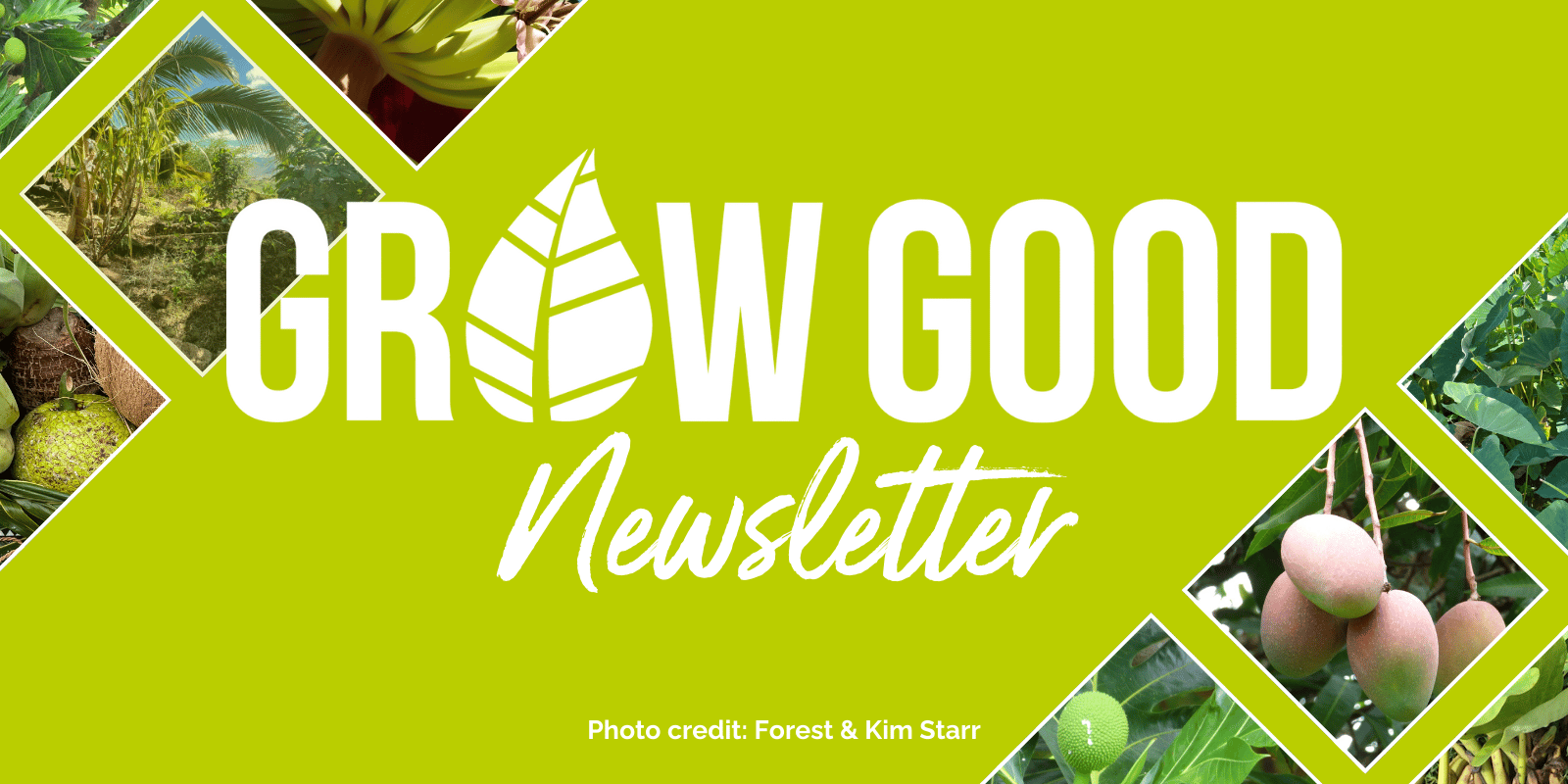
Friday, March 7, 2025
Aloha! Grow Good Hawaii is excited to introduce the Grow Good Newsletter; a newsletter where we share what we are up to and how you can grow more food, plant more native plants, and bring nature and abundance back from mauka to makai.
A word from Paul Arinaga, Executive Director of Grow Good Hawaii
Aloha mai kākou,
“When you get lemons, make lemonade,” they say. The federal grants freeze has been a big, sour lemon for us. Much of our lifeblood was suddenly and unexpectedly cut off. As a result, we have had to temporarily pause our biggest project, Trees for People: Growing an Urban Community Food & Native Forest. We’re busy making lemonade, however. And that’s where you come in. You can help to supply some of the “sugar” so we can make the sweetest, tastiest lemonade ever. We’re not ones to give up so we’ve devised a new plan that you can read about below. Please consider helping us to continue this valuable work. Trees for People is not our only project, however. The Go Native Project continues, and we have some exciting developments to share. We’re also working on scaling up Go Native in a pilot project in Kulio‘ou‘ou Valley. In Kaiāulu O Kuliʻouʻou, we hope to co-create with the community Hawaii’s first intentional urban forest. We’re also dipping our toes into riparian restoration with the project Puʻuhonua: Distributed, Scalable Phytoremediation of the Ala Wai Watershed Using Native Hawaiian Plants, a collaboration with ʻIolani School that is funded by the University of Hawaii Sea Grant College and is testing the use of floating islands of native plants to clean the waters of the Ala Wai Canal. I’m a big believer in the importance of culture & the arts, as well as in integrating them with STEM, the social sciences, and the humanities. I also think that people need to be able to imagine a different reality than the current one. This is exactly what our latest project, Re-imagining Wao Kānaka: Painting the Urban Forest as if it’s already there does. The project is part of celebrations for the Year of Our Community Forests, which was proclaimed by Governor Josh Green in January. You can read about it below. As you can see, we’ve got a lot on our plate. None of this would be possible without your support. Thank you. I’m also blessed with a team of highly motivated and talented staff and your financial support, encouragement, ideas, and volunteer time helps us to keep going. Mahalo nui loa and see you in the Urban Forest!
Me ke aloha,
Paul
Breaking News: Update about Grow Good Hawaii’s federal funding
As of this morning, Grow Good Hawaii was informed by the US Forest Service that federal grant payments will resume. We are not sure if this will remain the case over the long-term, however, and are therefore adopting a cautious “wait & see” approach regarding this funding. We will keep you informed regarding the federal grant funding the Trees for People Project as we learn more.
Once we are convinced that the restoration of federal funding is permanent, if you donated to our Rise Now campaign and would like a refund, we will be happy to provide one. Otherwise, your donation will help us weather future unexpected events (we are a small organization with limited cash reserves) or be used for one of our many other worthwhile projects. You can read more about these projects in this newsletter!
In this Issue
- Our Mission
- Overview of Our Projects
- Meet the Team
- Special Features
- Upcoming Events
- Plant Spotlight

Grow Good Hawaii’s mission is to restore nature and strengthen Hawaiʻi’s food security by implementing community-based, agroecological solutions in urban areas. We focus on urban—or human-inhabited—areas because we believe in community empowerment and because these areas can connect upland nature with coastal ecosystems and the ocean. They are the “missing link” in bringing nature and abundance back from mauka to makai. How are we doing this? Read below for an overview of our current projects!
Urban Agroecology is the missing link to restore nature and strengthen Hawaiʻi’s food security.
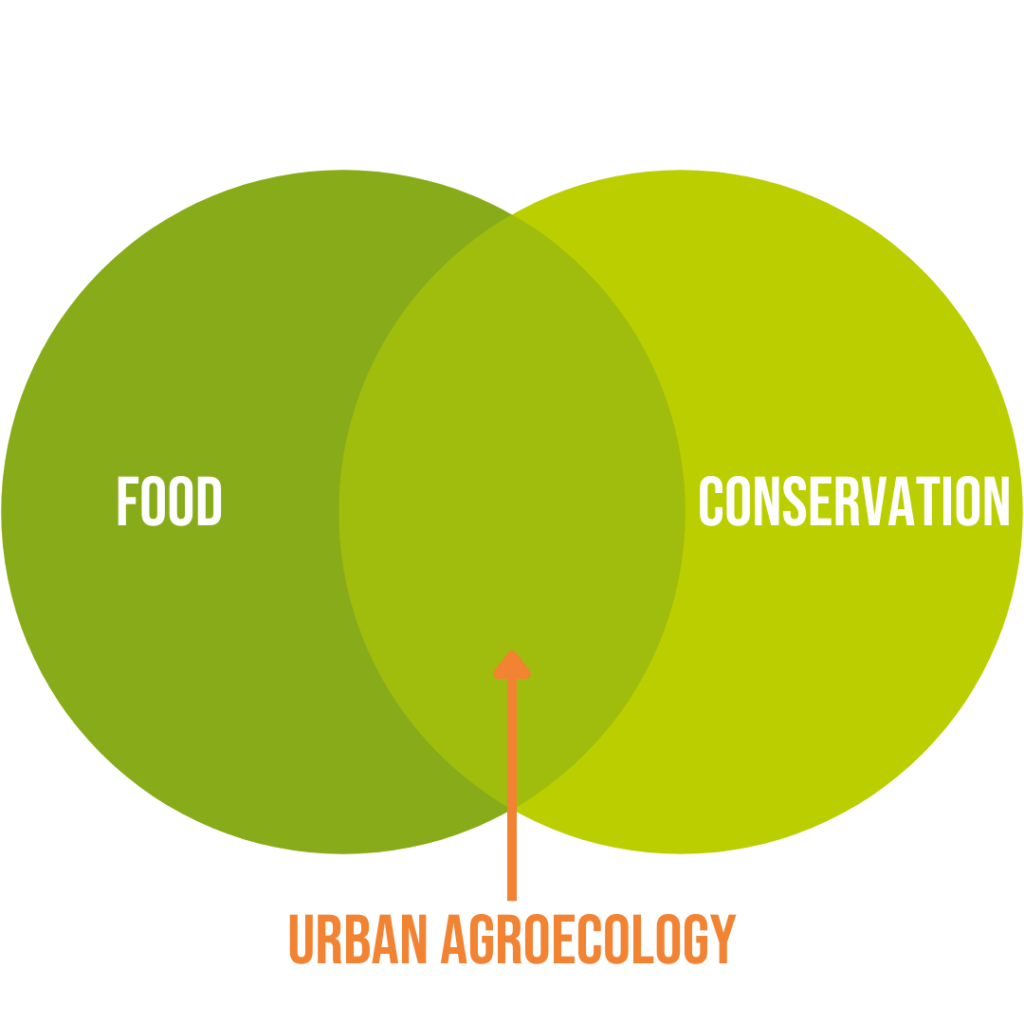

Trees for People: Growing an Urban Community Food & Native Forest
The Trees for People: Growing an Urban Community Food & Native Forest project seeks to increase the food security of underserved communities in Waiʻanae and Waimānalo. It accomplishes this by teaching community members how to produce a portion of their own food using agroforestry techniques. The project is funded by a $5 million, 5-year grant from the USDA Forest Service Urban & Community Forestry Program. Working with community partners, we are promoting agroforestry and distributing 2,000 trees (mostly fruit trees) as well as food and native understory plants to “backyard growers” in Waiʻanae and Waimānalo.
To make establishing a garden easier, we are developing “Backyard Agroforestry Blueprints.” These template designs will enable project participants to apply agroforestry techniques in compact urban spaces. By using agroforestry techniques, they will be able to improve tree health, grow understory species to increase plant diversity (thereby reducing pest pressure) and minimize bare ground (increasing water retention and reducing weed recruitment). The use of an agroforestry approach will thus enable participants to increase their food security, while enjoying the benefits of improved health, increased access to nature, and greater tree canopy (shade and cooling).
in the Trees for People Project, we are working with the following well-respected partners, many which have served their communities for several decades:
- ʻElepaio Social Services Services of the Waiʻanae Coast Comprehensive Health Center (Waiʻanae)
- Hoa ʻĀina O Mākaha (Waiʻanae)
- Hui Mālama O Ke Kai Foundation (Waimānalo)
- Kupu
- The Urban Garden Center of the University of Hawaii’s College of Tropical Agriculture and Human Resources.
Trees for People DIY
Trees for People DIY is a scaled-down version of our original Trees for People project. The plan for this project was created shortly after the federal freeze of the US Forest Service grant began for the original Trees for People project.Trees for People DIY ensures that the hard work our team invested in the original project is not lost. With support from donors, Trees for People DIY aims to promote urban agroforestry by providing trees, shrubs, and other understory plants to 100 households each year. This project is open to any household on Oʻahu. In an effort to keep these gardens alive, we will give hands-on growing support to up to 100 households per year and manually monitor the health of these tree to keep them alive. Stay tuned for more details on how you can be a part of Trees for People DIY!
Go Native: Growing a Native Hawaiian Urban Forest
The Go Native project was founded by Grow Good Hawaii’s Executive Director, Paul Arinaga. It aims to mobilize Hawaiʻi’s residents, businesses, schools, and other institutions to grow more native Hawaiian and Polynesian-introduced plants. Paul and Grow Good Hawaii’s Program Director, Hilary Parkinson, co-authored Go Native! Your guide to growing Native Hawaiian and canoe plants wherever you live, work, or play which was published in August 2022 (and available at a variety of local book shops including Book Ends and da Shop, or online here: https://amzn.to/3zR7CMo). The guide provides sample garden plans as well as recommended combinations of plants that are appropriate to the user’s growing zone, type of space, and landscaping needs. It includes a comprehensive listing (the “Quick Reference Table”) of 200+ native Hawaiian and canoe plants that readers can consult to match plant characteristics with their specific needs.
Native Plant Ambassadors and the Go Native Portal
To better support those starting a native plant garden or facing challenges with an existing one, we’ve launched two new initiatives: “Native Plant Ambassadors” and the “Go Native Portal.”
Native Plant Ambassadors are people who are interested in native plants and want to introduce them into their neighborhoods. They don’t need to be experts—anyone can become an ambassador as long as they are willing to coordinate a network in their area. We can bring in specialists when needed. Our goal is to create a supportive community where people can learn from each other and hopefully form new friendships.
The “Go Native Portal” will be a web-based app and community hub where gardeners can ask questions, share knowledge, and organize in-person meetups (for seed exchanges, plant swaps, community potlucks, native plant hikes, etc.). While there are many great online resources for native plant questions, this portal will make it easier for users to search previously asked questions and find nearby Native Plant Ambassadors. Additionally, any questions that can’t be answered within the community will be escalated to specialists, ensuring the portal remains a trusted, reliable resource.
As a supporter of Grow Good Hawaii, we wanted to give you a special sneak peek of the web-based app that will be on the portal:
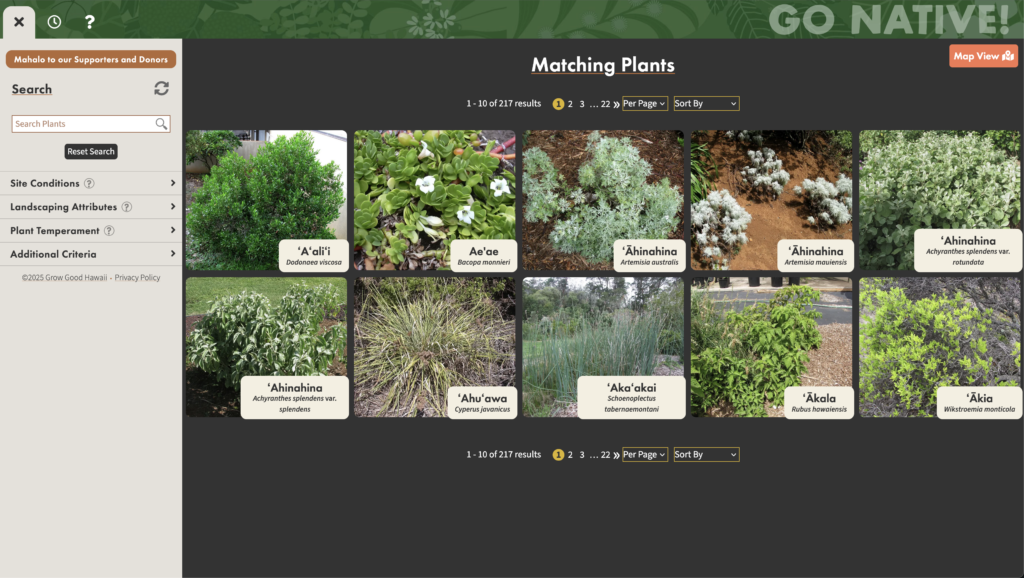
When you enter the online web app, you can search for specific plants or use various filters that help you find plants that match your growing conditions.
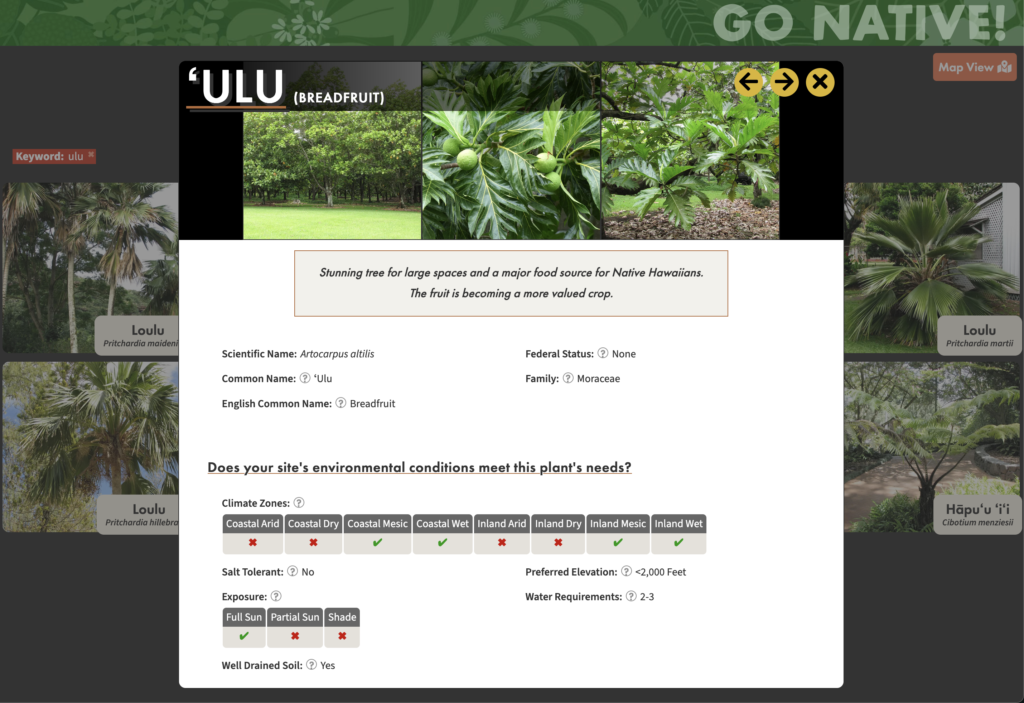
Each plant has information that helps you decide if it fits your site’s environmental, landscaping, personality, and ecosystem benefits/ethnobotanical needs.
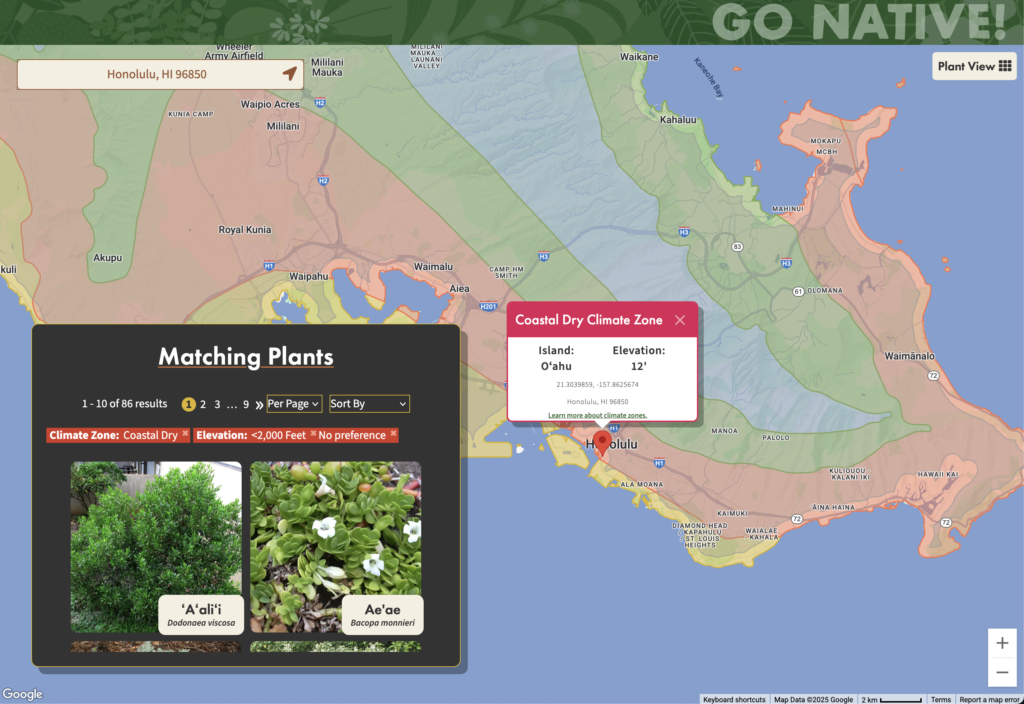
Not sure what filters to select for your site? The web app will have a map feature that automatically filters for you when you enter the site’s address.
Kaiāulu O Kuliʻouʻou – Creating Hawaiʻi’s First Urban Forest
Kaiāulu O Kuliʻouʻou is one of the next major steps in the Go Native Project. The plan is to mobilize residents in the ʻili of Kuliʻouʻou (Waikīkī Ahupuaʻa, Kona Moku) to create gardens of native Hawaiian and canoe plants. These can then form the nucleus of a Native Hawaiian Urban Forest in Kuliʻouʻou Valley, which could then connect with restoration efforts by our partners and friends at The Aloha Tree Alliance (mauka) and Mālama Maunalua (makai). To the best of our knowledge, this would be the very first intentional urban forest—focused on a specific geography—in Hawaiʻi! Our “Big Hairy Audacious Goal” (BHAG) is to have 200 households (approximately 10% of the 1,966 Kuliʻouʻou households) create and maintain native gardens over five years. Fortunately, through a unique partnership with Kuliʻouʻou residents John & Sandy Correa, we believe that this ambitious goal is achievable. The extended Correa ʻohana live in 30 separate households in the valley (they even have their own annual Christmas parade!) and John & Sandy believe that they can convince at least 15 of these households to start native plant gardens. From this base, we can grow the Kuliʻouʻou Native Hawaiian Urban Forest!We are so grateful for John and Sandy Correa’s interest, time and enthusiasm for this project.
“We were inspired by the work of Aloha Tree Alliance to replace invasive species with plants native to the valley our ʻohana has lived in for over a century. They introduced us to Grow Good Hawaii to further that work. We are also trying hard to protect our home from wildfire risk. We love where we live and want to nurture it for our ʻohana’s future.”
— John & Sandra Correa
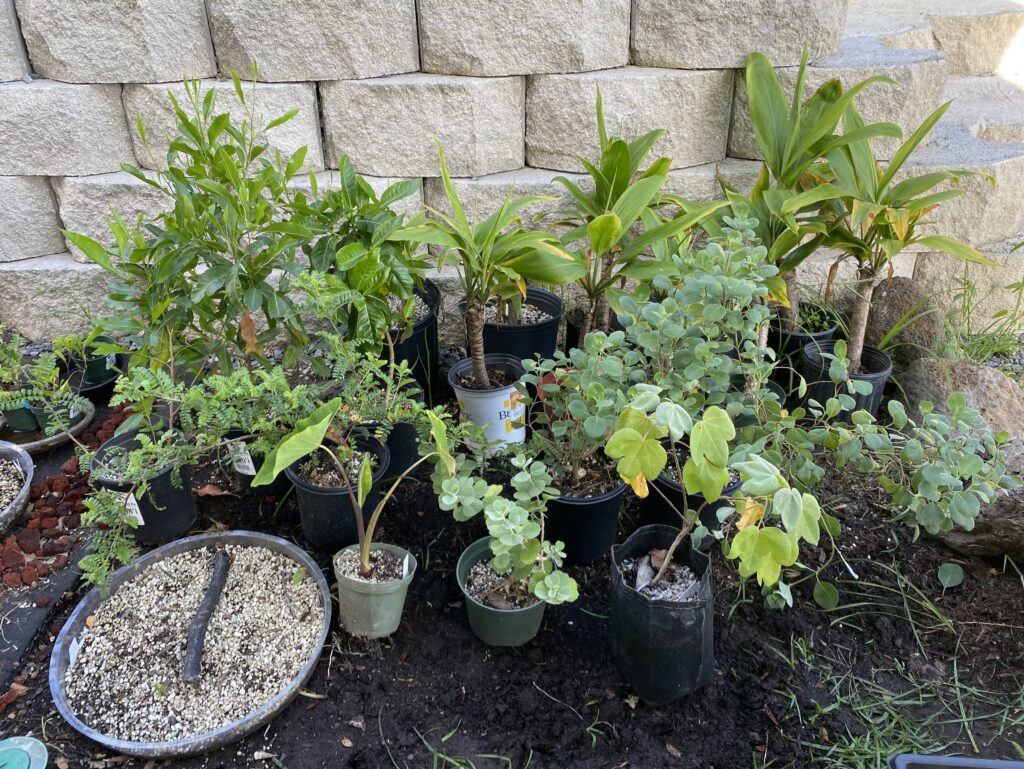
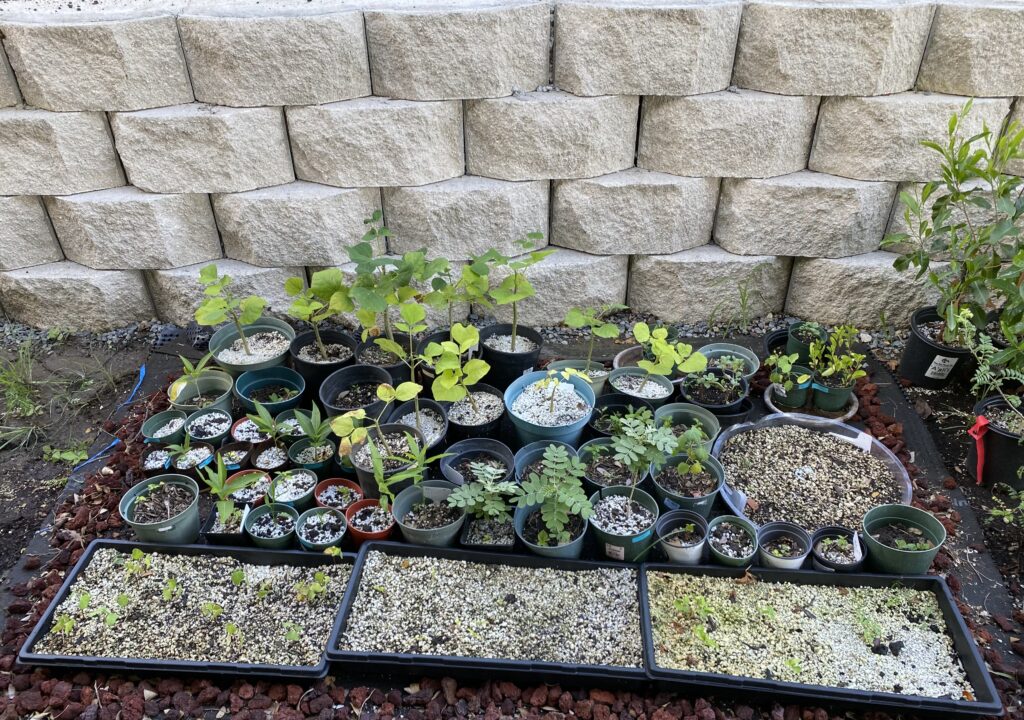
Rick Quinn donated the seed for numerous trees and shrubs for this project (thank you Rick!). Grow Good Hawaii staff provided directions to Sandra on how to propagate those species (thanks largely to Kerin L. Lilleeng-Rosenberger’s Growing Hawaii’s Native Plants: A Simple Step-by-Step Approach for Every Species). After some trial and error, and a few Zoom calls: success! The Correa family is growing a lot of their own native plants for this project and is willing to donate extras to friends and family participating in the project. Goes to show: “Teamwork makes the dream work”!
Year of Our Community Forest
2025 is the Year of Our Community Forests! The campaign was created by a partnership of tree lovers, including multiple partners, the DLNR Forestry & Wildlife and its Kaulunani Urban & Community Forestry Program. To celebrate the Year of Our Community Forests, Grow Good Hawaii is working with a local artist to paint a mural in downtown Honolulu.
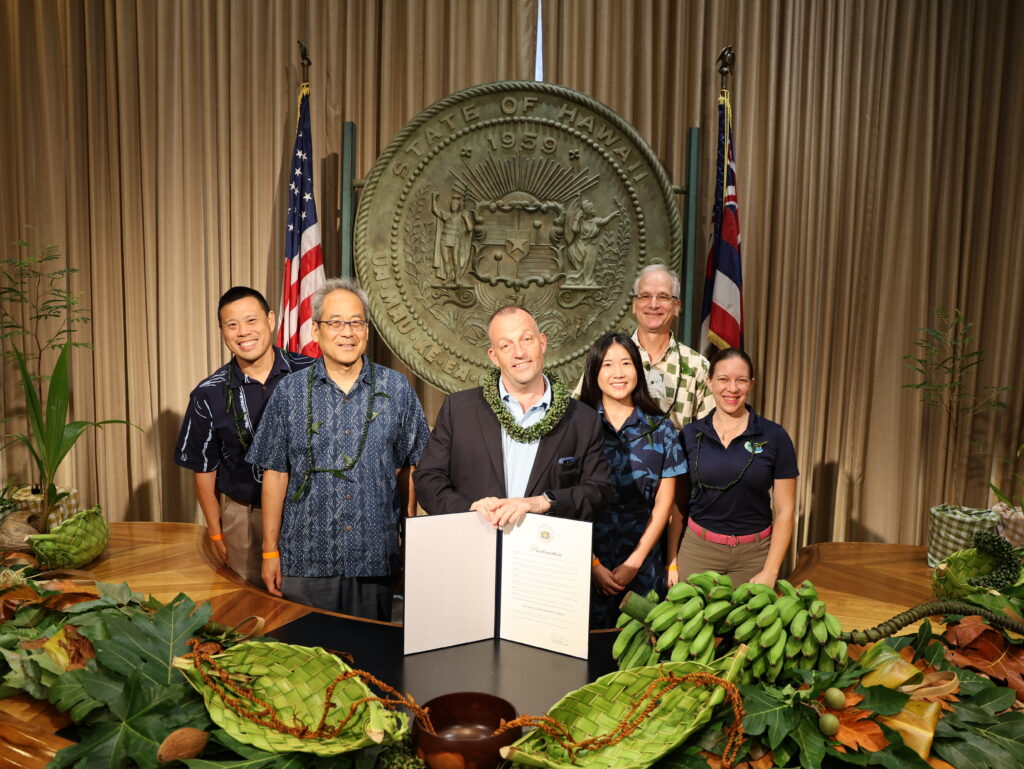
Earlier this year, Paul attended the Governor’s proclamation of the campaign.
The mural, titled “Re-imagining Wao Kānaka”, will help the community visualize the urban forest as if it already fully exists. Using the French painting technique of Trompe-l’œil (a highly realistic optical illusion of three-dimensional space and objects on a two-dimensional surface) we will paint a large photo-realistic mural of a natural forest enveloping a building in a prominent downtown Honolulu location. Passersby will be “tricked” into thinking that the urban forest already exists. This will help them to imagine what urban Honolulu could look like as a city nestled within a forest. Ultimately, populating their minds with this vision could lead to greater value being placed on creating actual urban forests. A companion website will provide opportunities for deeper education and engagement. As a bold and innovative statement in a landmark location, this mural will be a visual kīpuka that attracts greater attention to the celebration of the Year of Our Community Forests.
Puʻuhonua: Distributed, Scalable Phytoremediation of the Ala Wai Watershed Using Native Hawaiian Plants
The Puʻuhonua project seeks to improve the water quality and biodiversity of the Ala Wai Watershed using phytoremediation. Several years ago, Paul wanted to test phytoremediation as a potential solution to clean up pollution in the Ala Wai Watershed but instead was persuaded to help start the Genki Ala Wai Project. Paul supported the Genki Ala Wai Project, but he never stopped thinking about using phytoremediation to clean up the watershed. So what is phytoremediation? It is the use of plants to clean pollution in soil, water, and air. It has been proven to work in other locations in Hawaiʻi (e.g., Kauai fishponds and streams) and it incorporates native plants that would normally be part of the natural ecosystem. In the case for this project, we will use puʻuhonua, floating wetlands of native Hawaiian plants, to apply phytoremediation to the Ala Wai Watershed.We have been working with two ʻIolani High School students on this project, and one of them, Christopher J. Aguillon, made it to the State Science Fair for his work on the biodiversity aspect of the project.
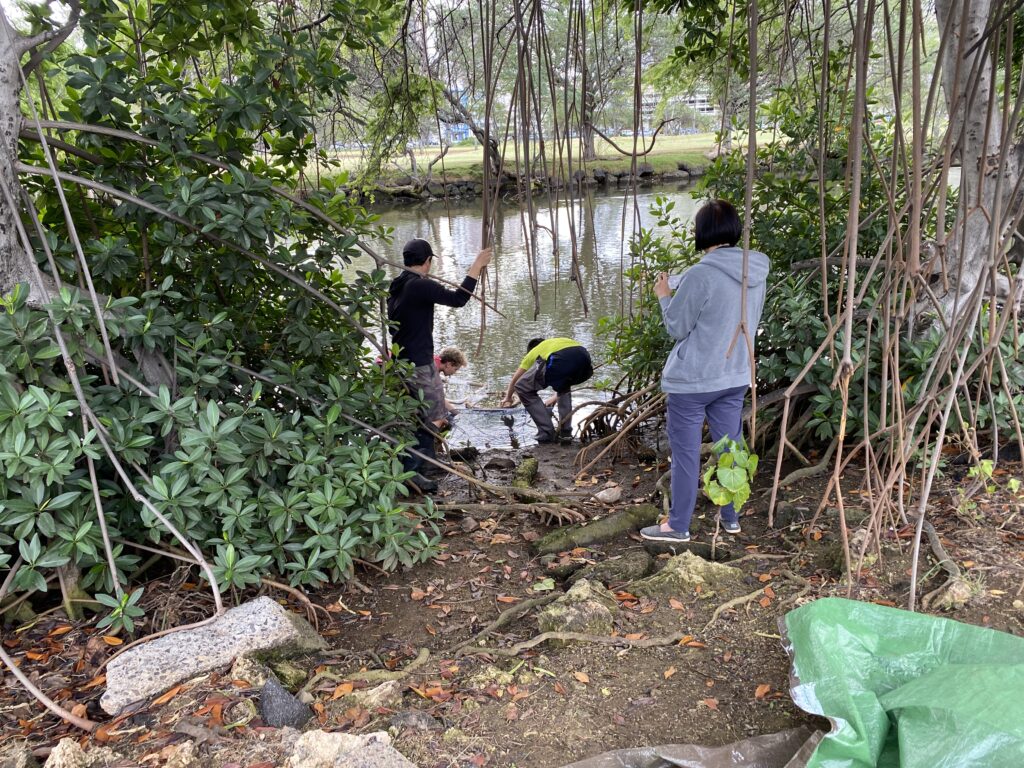
Checking the floating islands of native plants and conducting the biodiversity count.

None of these projects could have happened without our amazing team of staff and partners. In each newsletter, we will take a moment to introduce you to a member of the team supporting our projects:
Meet Martín!
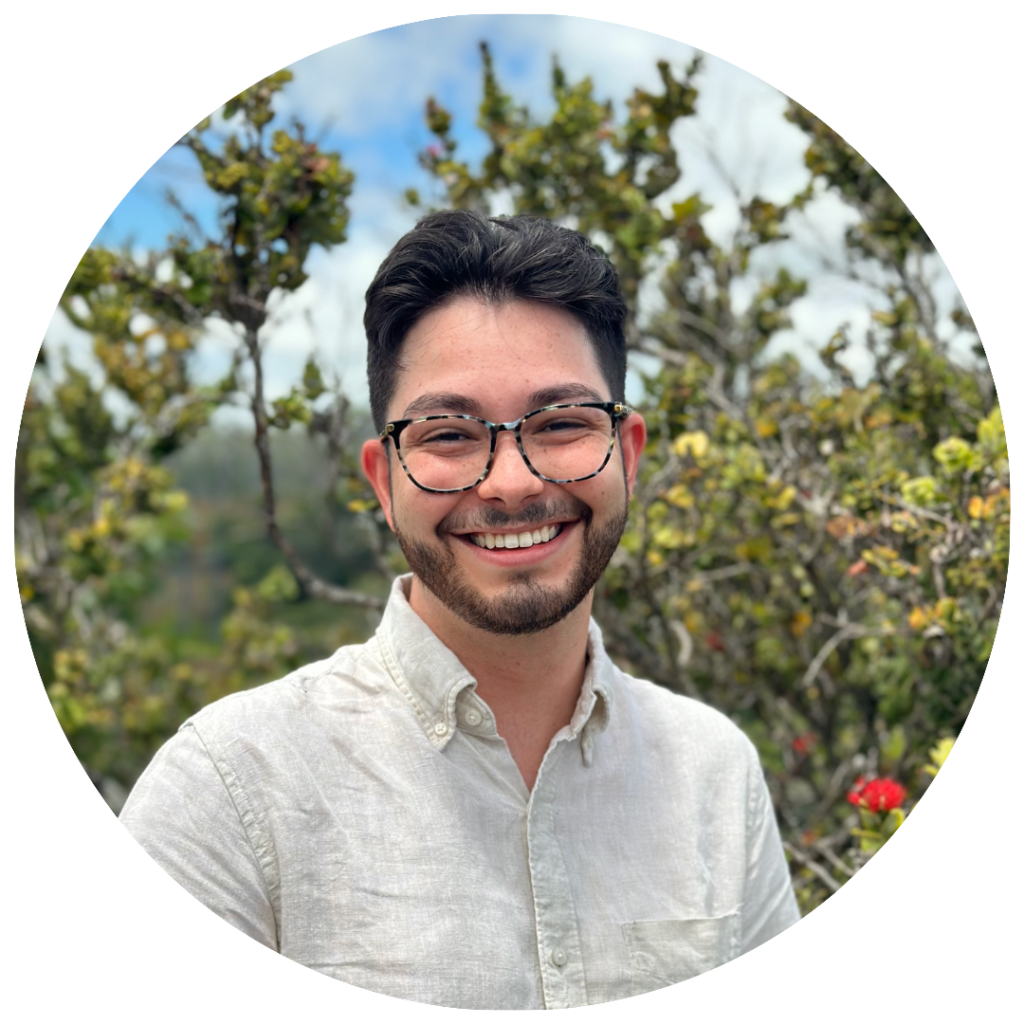
Martín Bañuelos is the Community Coordinator at Grow Good Hawaii. As the son of two subsistence farmers, Martín has a personal connection to agriculture and the environment. He has core memories of helping his family in Mexico plant maíz, grind its kernels for flour, and cook it into tortillas.Martin grew up in Inglewood, CA, which shaped both his professional aspirations and community values of shaping greener environments and communities. Martin spent time on Hawaiʻi Island sampling bugs from agroforests and farming lettuce in an aquaponic system. Before joining Grow Good Hawaii, Martín worked to reduce and eliminate toxic chemicals from consumer products and the environment. As a visitor on ʻōiwi lands, he appreciates being able to contribute and support work that gives back to the ʻāina and enriches communities on the island. Martín has a B.S. in Conservation & Resource Studies from the University of California, Berkeley.
Q: What is your favorite fruit?
A: I love a lot of fruit, but I recently fell in love with papaya. I think my love began when I started working at Grow Good Hawaii! With all the discussion around fruit and fruit trees, it was hard not to start craving it. Papaya has a mild sweetness to it that is a refreshing addition to breakfast. The tree is also adorable. It’s the perfect size if you have a small yard or want something that stands out in a garden.
Q: What is your favorite native Hawaiian plant?
A: ʻŌhiʻa lehua (Metrosideros polymorpha). When I first visited Hawaiʻi, my partner taught me about the importance of ʻōhiʻa in Hawaiʻi and ʻōiwi culture. I’ve been in love with the tree ever since. It has really beautiful and delicate flowers that pop out on a hike. I have seen many reds, some orange, and a few yellow, but I am waiting for the day I find the mythical white ʻōhiʻa. I recently heard there is even a purple one! Here are some of my favorite finds:

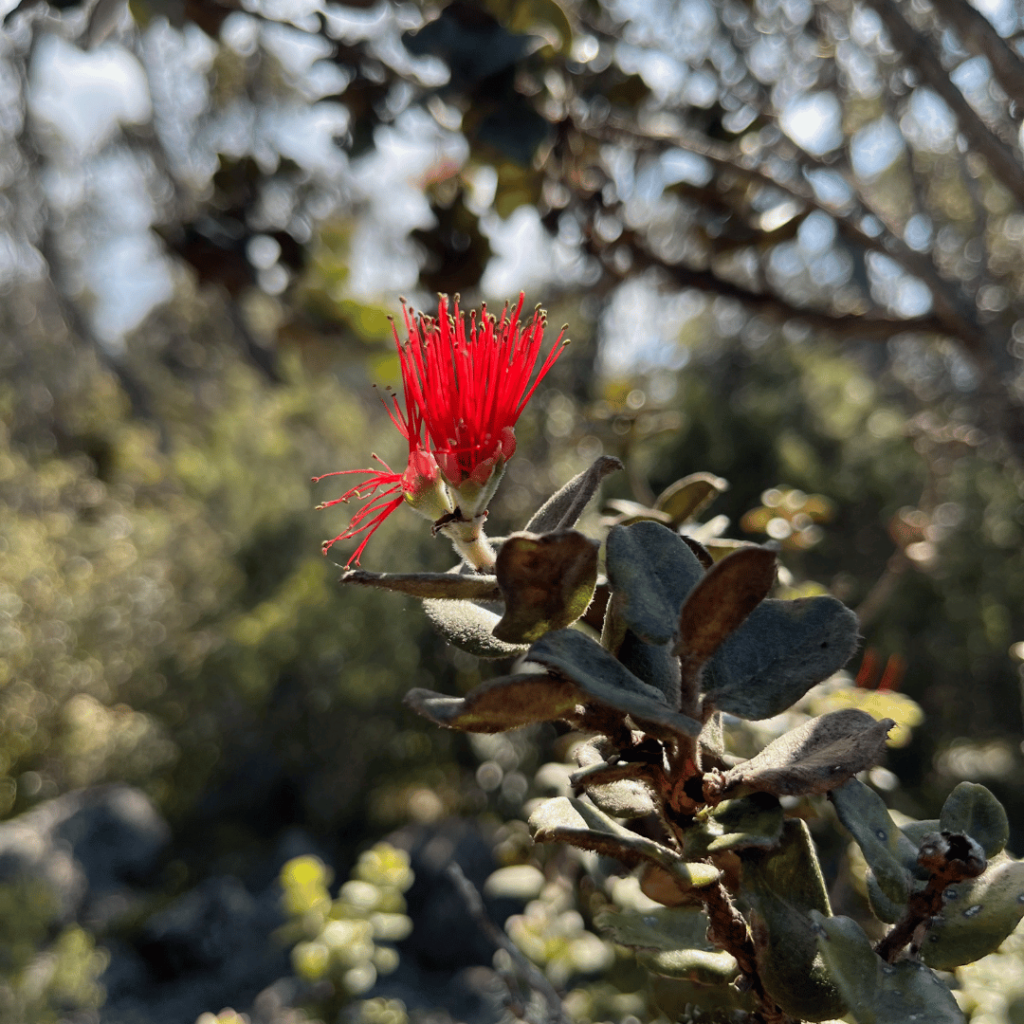
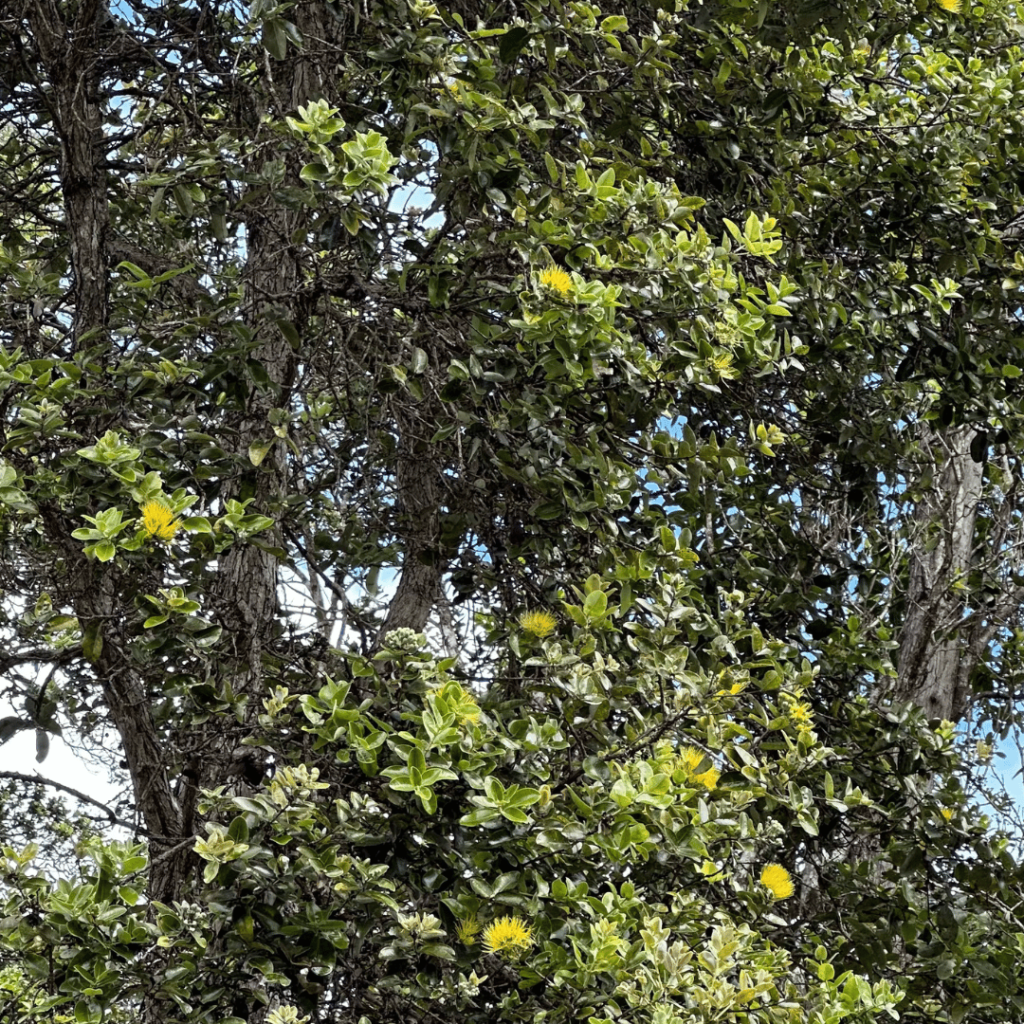
I found all of these recently on a trip up Mauna Loa on the Big Island.

Learn about Native Plant Ambassadors
Our first Native Plant Ambassador meeting took place last fall at Lucas Morgan’s home in Hawaiʻi Kai. Neighbors gathered to meet others interested in native plants and hear from some excellent speakers. Tom Foye, co-author of the Go Native book, discussed the history and growing interest in using native plants in urban areas. Landscape architect Rick Quinn shared design tips, emphasizing the need for more flexible designs with native plants and recommending minimal or no fertilizer use. Lucas Morgan spoke passionately about how native plants connect us to our local surroundings He highlighted endemic species that exist here and nowhere else and how they link us to the world, such as aʻaliʻi, which is found both in Hawaiʻi and Afghanistan.The next meeting will be hosted at Tom Foye’s home and will feature a panel of expert speakers, including Kristen Kane, who will discuss her experience designing with native plants, and Jacob Roberts, a sustainability specialist, who will speak about soils. Unfortunately, this event is already full, but if you’re interested in attending a future meeting in your neighborhood or becoming a Native Plant Ambassador, please let us know! Email us at [email protected].
Presenting the Go Native project to the public
Interest in the Go Native book continues to grow! Last fall, the Department of Education invited Grow Good Hawaii to present the book and its applications to a group of teachers as part of a continuing education course. Fifty teachers attended, and it was exciting to answer their questions and see their enthusiasm for using the book to start or expand native plant gardens at public schools. We thank the Department of Education for giving us the opportunity to support teachers’ efforts to include native plants on campuses and possibly in curriculums.
Soon, the quick-reference table from the Go Native book will be available as a filterable web-based app, expected to launch by mid-March. When Paul and Hilary presented this tool at the Rain Harvest Workshop at Aliʻiolani Elementary School, the audience was eager to use it and excited for its release. This new web-based app makes the “Quick Reference Table” from the book even more user-friendly. It includes a mapping feature that allows users to enter their address, identify their climate zone, and automatically display plants suited to those conditions (right plant, right place!). The app also offers filters for various criteria found in the book (such as height, plant form, and flower color), as well as new filters not included in the book. These new filters include selecting for plants that attract yellow-faced bees, honey bees, forest birds, as well as plants with specific ethnobotanical uses and more. We thank Cyrus Howe of Hawaiʻi Green Growth for organizing this workshop and for fellow presenters for participating in events like this to make homes more sustainable. And if you missed the workshop, but are interested in reducing storm water runoff on your property, go to https://www.hawaiigreengrowth.org/ftd for an application on free rainwater assessments (available for a limited time).
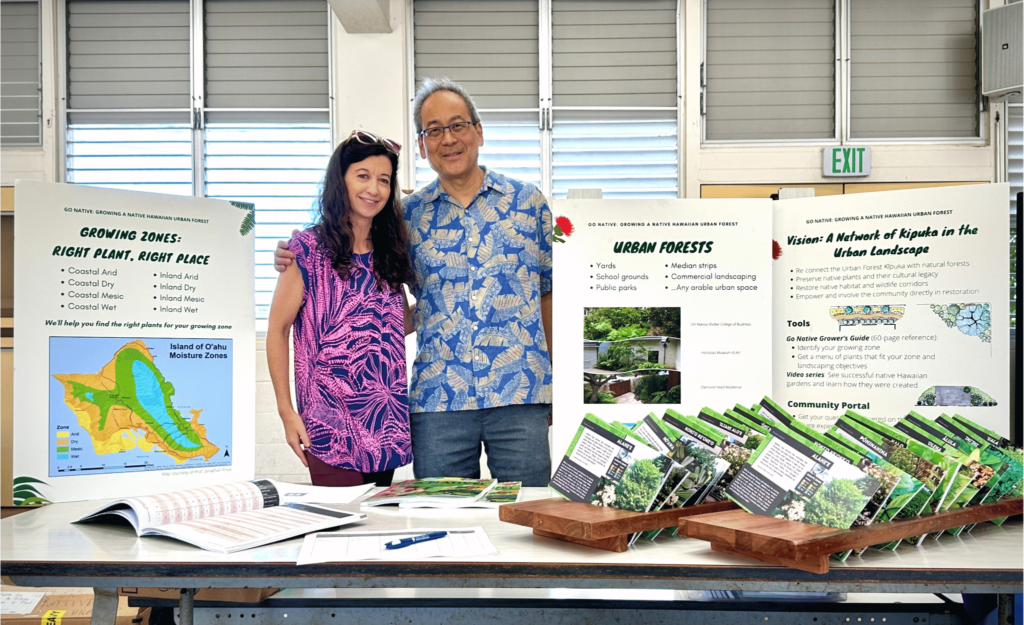
Paul and Hilaryʻs display of the Go Native project at the Rain Harvest Workshop.
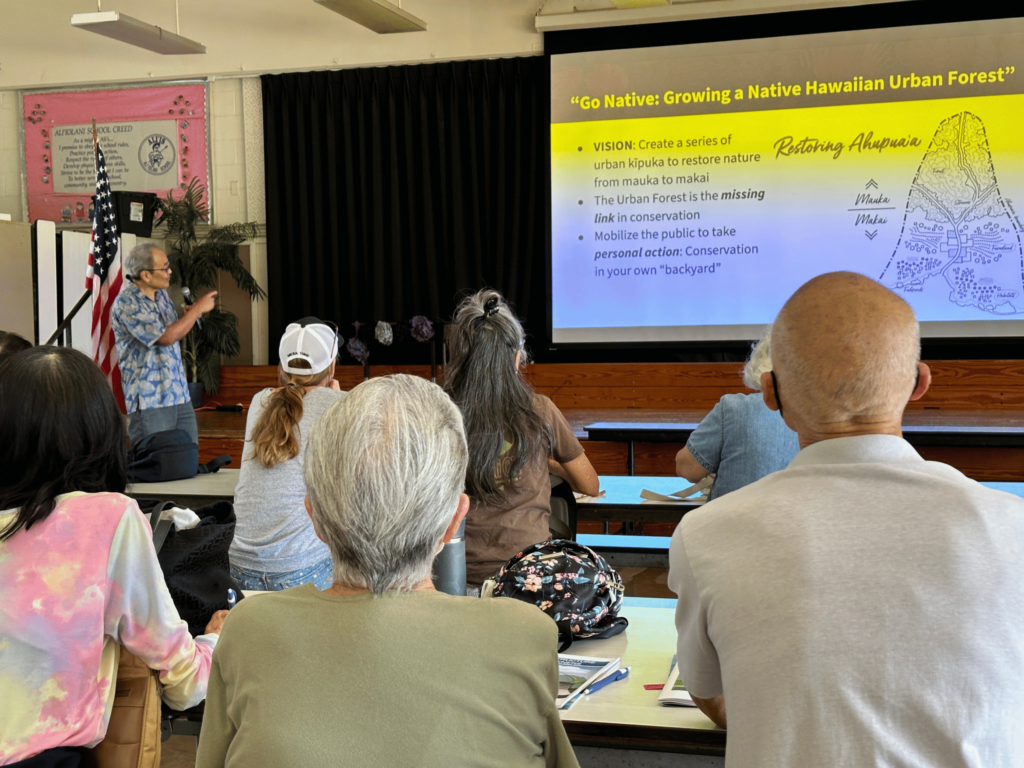
Paul presenting to attendees about the Go Native project.
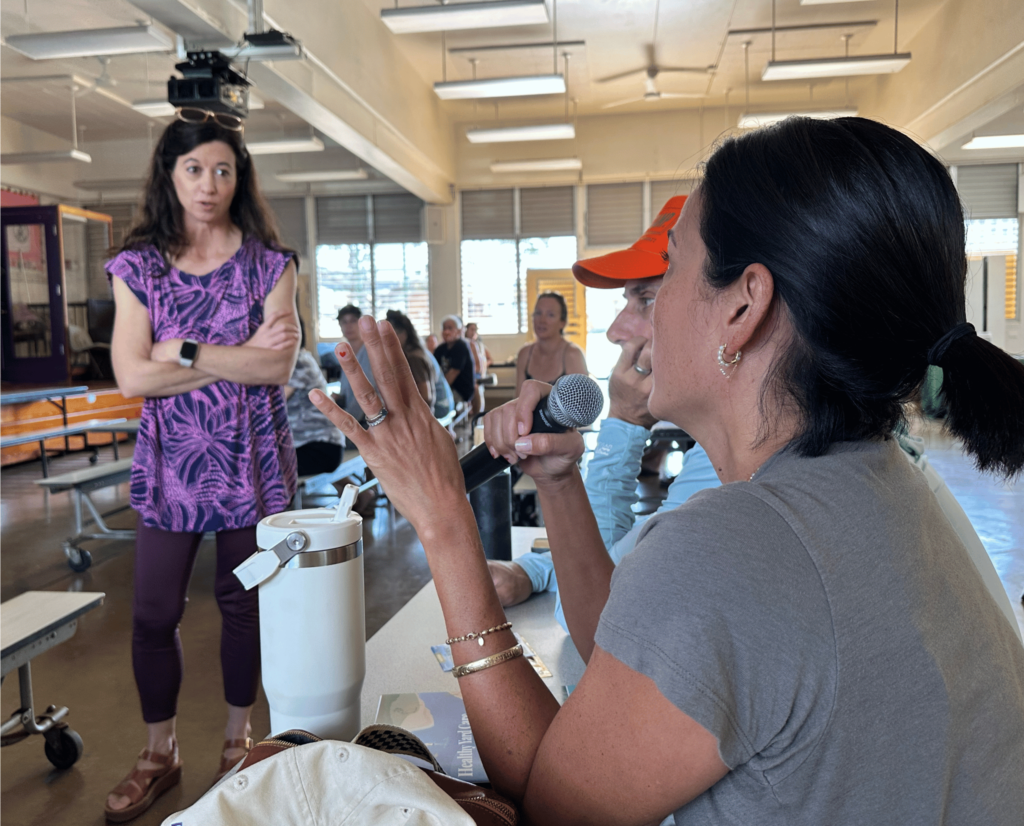
Hilary answering questions from attendees.
Read Paul’s opinion piece: “Hawaiʻi’s Charitable Sector Urgently Needs Assistance” on Civil Beat.
Paul recently wrote a piece discussing the freeze of federal grants, how it greatly affects non-profits, and what it means for the future of non-profit fundraising.

March 10, 2025, at 7:00 PM – Grow Good Hawaii presenting at the Waimānalo Neighborhood Board Meeting
Do you live in Waimānalo and want to learn more about how to get a fruit tree and agroforestry garden? Do you live outside Waimānalo but want to learn more?
Join us at the Waimānalo Neighborhood Board Meeting this upcoming Monday, March 10, 2025, at 7:00 PM. You can attend the meeting in person or online. See you there!
Meeting information
In-person location: Waimānalo Public Library Meeting Room, 41-1320 Kalanianaʻole Hwy, Waimanalo, HI 9679.
Online Information
Meeting link: https://cchnl.webex.com/cchnl/j.php?MTID=m4eab55b312ed0a612abb6a9bc7720f93
Meeting number: 2496 613 1930
Password: NB32 (6232 from phones and video systems)
Join by phone: +1-408-418-9388 United States Toll

Pāʻūohiʻiaka (Jacquemontia sandwicensis)
Pāʻūohiʻiaka is a versatile native plant that looks stunning spilling over rock walls, or in hanging baskets to showcase its funnel-shaped white or sky-blue flowers. If you live in a particularly dry area and are looking for a drought-tolerant alternative to turf grass, consider this plant. While not appropriate for areas with a lot of foot traffic, it’s an excellent ground cover that will fill in quickly. Along with helping you save water; its flowers are appreciated by honeybees and the native (and endangered) yellow-faced bee. A moʻolelo on this plant suggests how quickly it can fill in as a substitute for turf grass. According to the story, Pele was out on the water and left her baby sister Hiʻaka on the beach. She was gone longer than expected and Hiʻaka fell asleep. A vine grew up and covered her like a skirt to protect her from the sun, hence the name “Pāʻūohiʻiaka”.
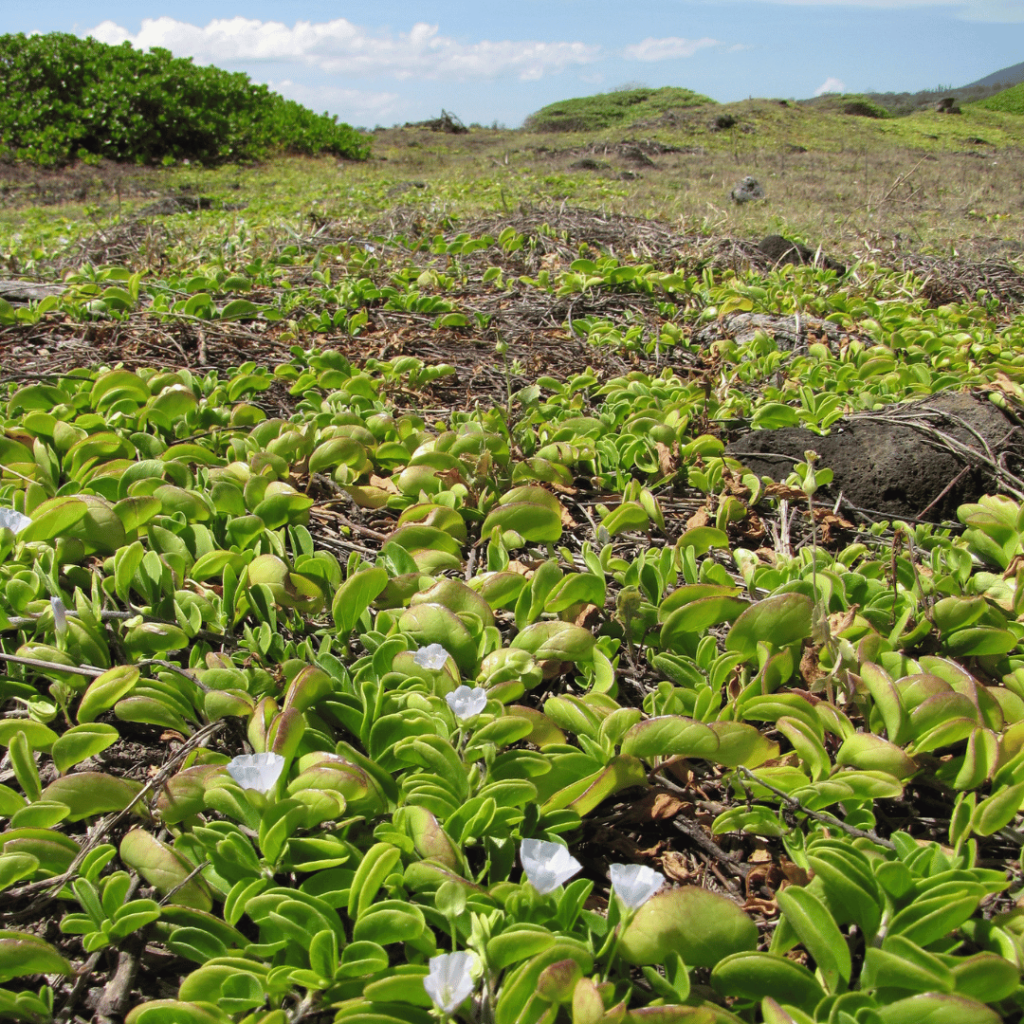
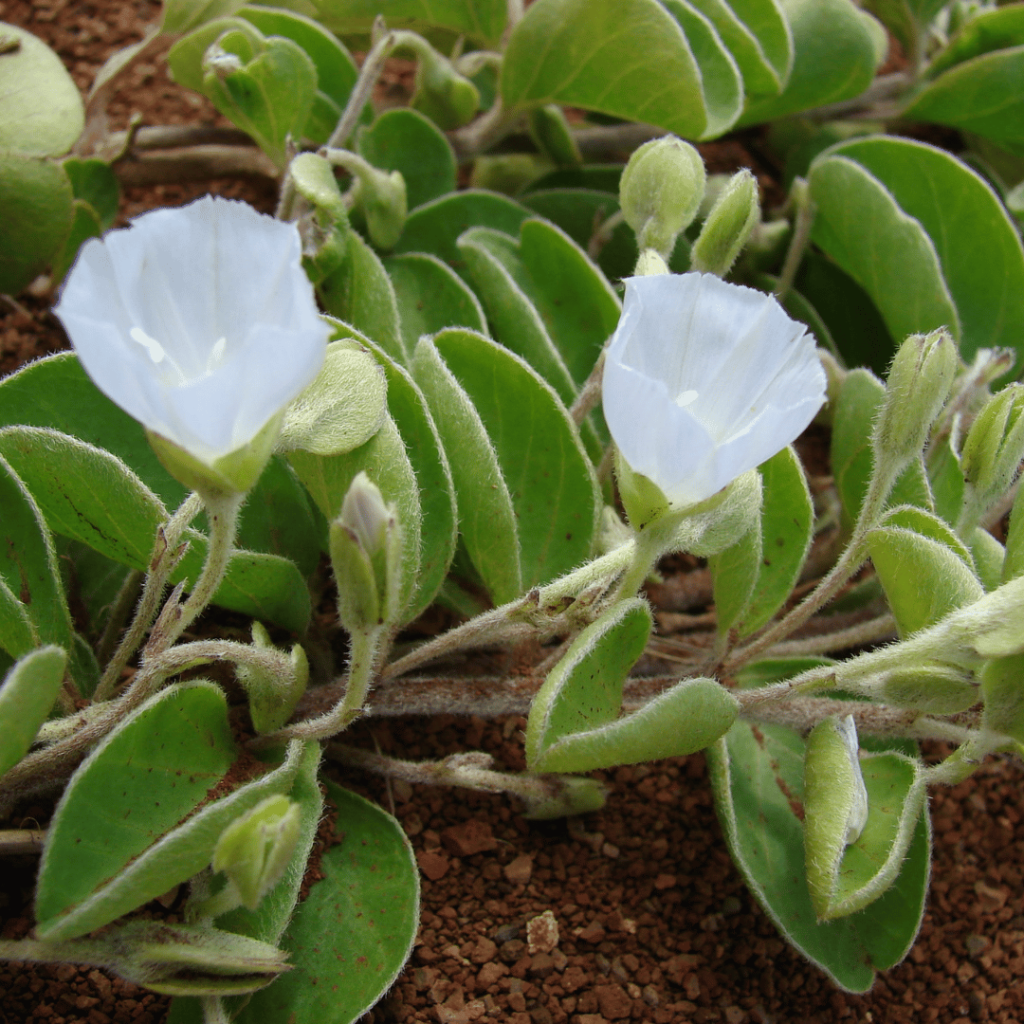
Photo credit: Forest and Kim Starr

